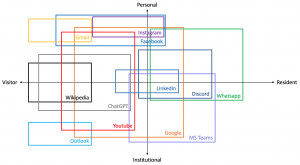To begin with, I must say “Online Participation and Digital Literacy” is the most appropriate first topic for an Open Network Learning (ONL) course session. Here is the reason, we had eight members in our group to work on this topic and around half of us were around double my age and are vastly experienced in their own domain but lacked critical digital literacy. It resulted in difficulties with their role in this widely digital era of teaching. To me, digital literacy comes before online participation, that is in reverse order of the title of the topic.
According to my opinion, digital literacy is the ability of a person to be able to use different digital tools in his/her regular activities. Since, it is related to more than one specific tool, Lankshear and Knobel argue to use ‘literacies’ rather than ‘literacy’ [1]. However, the concept of visitor and resident of the digital world is very interesting to me as it can be illustrated precisely using a map/grid for one’s digital literacy [2]. This digital literacy map was introduced by David White in a webinar on this topic. In short, being a visitor, individuals decide on the task they wish to undertake with the help of digital tools and go offline or move to another task (e.g., searching for information on Google). On the other hand, the resident mode is all about social presence by posting comments, blogging etc. (e.g., commenting on a friend’s Facebook post). However, one’s digital literacy also spans from personal to institutional use. To make us understand our own digital literacy, David conducted an exercise to draw our own map during the webinar. Here is the map that I drew for myself and I believe that over time the boxes would become smaller or shift sides.

Upon knowing individual digital literacy, one can further work on to further develop themselves with different digital tools. Interestingly there are prescribed ways to develop digital literacies too. There are also lots of peer-reviewed articles that can help individuals to increase their ability to use digital tools. However, from the suggested reading for the topic, the pyramid model by Beetham and Sharpe [3] caught our group’s attention as the centre of the solution to this topic. In short, the pyramid model consists of four aspects: identity, practices, skills and access & awareness. Though it is depicted as a pyramid, to me it is more of a circle because all the aspects come in turn to develop one’s digital literacy. Furthermore, we complemented the pyramid model from teacher and student perspectives with an illustrative and interactive tool. The tool can be accessible at https://onl231pbl05topic1.netlify.app/.
References:
[1] Colin Lankshear and Michele Knobel (editors), 2008. Digital literacies: Concepts, policies and practices. New York: Peter Lang [Available Online].
[2] David White and Allison Le Cornu, 2010, “Visitors and residents: A new typology for online engagement,” First Monday, volume 16, number 9 [Available Online].
[3] Developing Digital Literacies, 2014, JISC Guide. [Available Online]